|
 Prehistoric Ireland:
(The 'Emerald Isles')
Prehistoric Ireland:
(The 'Emerald Isles')
The range of dates from the
Carrowmore complex (5,400 BC-Tomb 4
to 3,100 BC-Tomb 56) (1), demonstrates
that Ireland was home to an uninterrupted tradition of megalithic
construction for over 2,000 years.
Perhaps it was the relative
geographical isolation of the island, the nature of the landscape or
some other factor, but whatever the reason, Ireland offered the
Neolithic builders the opportunity to express an aspect of themselves
in a way which is often not clearly understood today, namely the
development of the relationship between people, their constructions,
the landscape and ultimately, the universe itself. This primitive form
of communication is seen through the placement and design of the Irish
megaliths, several of the most significant of which are located in
such a way as to be inter-visible with each other, simultaneously
incorporating significant solar or lunar orientations in their design
and
complimented by engraved symbols that tease us with their simplicity.
The Irish megaliths offer some of the best
examples of megalithic art in Europe. The significant association with
'solar-wheels', spirals, lozenges etc, at locations with an
astronomical significance suggests an relationship, but one which is
not yet clearly understood.
|
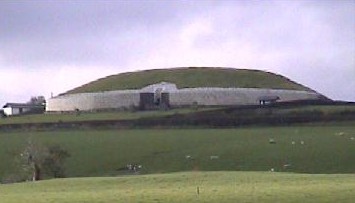 The Boyne-Valley complex:
(Newgrange,
Knowth and
Dowth). The Boyne-Valley complex:
(Newgrange,
Knowth and
Dowth).
Set
on a curve of the River Boyne, this megalithic complex is perhaps
the best known of all Irish sites. The three main passage mounds and
their satellites are orientated and aligned, so as to indicate the
arrival of significant days in the solar and lunar cycles. The
structures in the Boyne valley act together like a huge observatory
which would have enabled the builders to have accurately calculate
and predict the motions of the sun, moon and earth, in a similar way
as at other complexes such as
Stonehenge,
Carnac or the Orkneys.
(More
about the Boyne Valley Complex) |
|

Light Boxes:
The Light-box (Left) at Newgrange is one of the most satisfying
relics from the Neolithic times as it reveals the builders of the passage mounds
as a highly skilled and organised workforce at the same time as identifying in
them a quality of intellect, calculation and having the mechanics to accurately
record the solar and lunar cycles.
Similar discoveries from the Orkneys, France and other Neolithic
locations demonstrates that accurately recording the solar and lunar cycles was
an extremely important part of the cultural identity of our European Neolithic
ancestors, but with at least two recorded Light-boxes and talk of more, the
Irish light-boxes take the trophy for excellence.
(More on the Subject of
Lightboxes) |
|
 Tara Hill: Tara Hill:
This site is regarded as the
'spiritual' centre of Ireland, in a similar way as Glastonbury is to
England. On the top of the hill is the 'mound of hostages' upon which stands
the 'Stone of Destiny', the very navel of Ireland.
The prehistoric and sacred landscape of the Tara Valley has been recently
desecrated by the building of a Toll-motorway through the valley.
(Destroying over 40 prehistoric sites in the process, including the
Lismullen Henge).
( More about the M5 Motorway - Tara Valley)
(More about Tara Hill) |
|
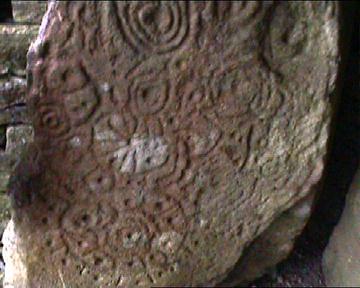 Loughcrew: Loughcrew:
A collection of over 30
passage mounds containing carved lintels, Kerb-stones, spirals and solar
'wheels'. This site is now recognised to have several significant
astronomical orientations, placing it alongside its Boyne valley neighbours
in importance. The inter-visibility of these two great sites offers an
insight into the way the megaliths and the landscape were used together as a
means of communicating our existence through symbolic design.
(More
about Loughcrew) |
|
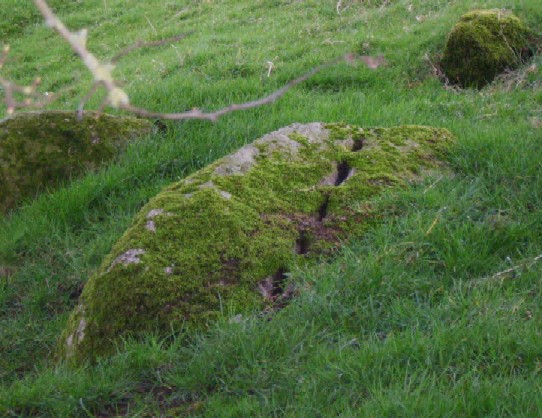 Castleruddery:
The idyllic atmosphere of this beautiful little Henge-circle is complimented
with some excellent examples of prehistoric
masonry techniques, similar to those found in France, Portugal, Egypt and around the
ancient world.
Castleruddery
is also home to two 50-ton quartz
portal-stones.
( More about
Castleruddery) |
|
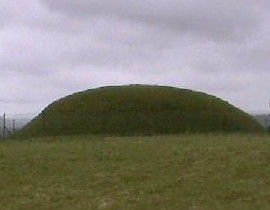 Four knocks: Four knocks:
This relatively small but perfectly rounded passage mound is
significant in that as well as being in view of the Boyne valley, it
contains some of the best examples of engravings in all Ireland, including
several similar to those found on the light-box
lintels at Newgrange and Gavr'inis.
(More
about Four knocks) |
|
 Browne's Hill Dolmen: Browne's Hill Dolmen:
Sadly,
very little is left of this once covered over 'Portal
tomb'.
Weighing in at an
estimated 150 tons, the granite capstone on this partially collapsed dolmen is said to be the largest
megalith in Ireland.
(More about the Browne's Hill
Dolmen)
|
|
Ireland's R.S.C's.
(Recumbent Stone Circles).
The Ross-Carbery
RSC's
-
The R.S.C's (Recumbent Stone Circles) found in the Ross-Corbery
area of southern Ireland are unique both in the fact they are the
only R.S.C's found off the UK mainland, and that they are solar in
orientation rather than lunar, as is the case with the numerous
Grampian R.S.C's in Scotland. There is a clear suggestion of contact
between the two regions.
(More about
Recumbent Stone Circles RSC's) |
|
The Boyne Valley Complex: |
Location - River Boyne,
County Meath, Ireland.
Description - The Boyne Valley complex is one of
Europe's greatest megalithic sites. It was constructed at around 3,300
BC, the same time as several other prominent megalithic complexes. It is
clear from the orientation of the passage-mounds that the whole complex
was devoted to accurate measuring of both the lunar and solar cycles
simultaneously.
The site was surveyed by Dr. Jon Patrick, who said of it:
'It has been shown that the Boyne valley monuments
were probably laid out to a design plan'
(2).

The three main features of the complex are
the passage mounds named
Newgrange, Knowth
and
Dowth. At present
Newgrange is open throughout the year, Knowth is open for parts of the
year only, and Dowth is closed the whole year round, but is free to roam
around the outside.
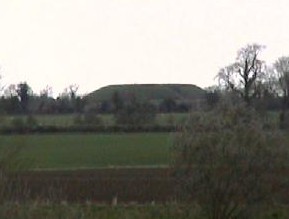

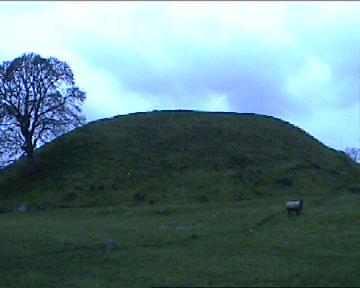
Knowth, Newgrange and Dowth.
The manpower and organisation behind the construction of these monuments
is on a civil scale. The guides at the site tell us that the average
human lifetime at that time was only 35 years and they estimate it took
70 years to build, from which we can comfortably deduce that it wasn't built as a tomb...
Astronomy - 'The map of the
external design plan of the complex (see above) demonstrates a concern
with solstices, equinoxes and cross-quarter days'
(2). There are 97
kerbstones on Newgrange, and only three of them are fully carved, their
astronomical positioning is 'highly significant', and it is the clear
from the extra energy involved in creating accurate alignments and
orientations that astronomy played a fundamental role in the structures
existence.
(More
about Archaeoastronomy)
The Newgrange Cursus:
A Cursus 'of unknown length'
(3), has
been found just east of Newgrange.
The
cursus is barely visible today but extended around 100 m from the
valley of the River Mattock to climb the ridge occupied by the
Newgrange tomb.
Here it is rounded off by a terminal bank. The cursus was around 20
m wide.
It is similarly orientated to the
mid-winter solstice, as is the passage mound itself.
(More
about Cursus)
The Boyne-valley complex is intervisible with other
prominent megalithic sites such as:
Tara Hill,
Loughcrew and
Four-knocks.
(More about the Boyne Valley
Complex)
|
The French - Scottish Connection: |
There are several noticeable
similarities between the megalithic structures of Ireland and those from
both France and Scotland. Contemporaneous construction features, carvings,
and the specific orientation of passages makes it difficult to ignore the idea that
they might have been built by the same extended cultural group.
Gavr'inis in France and
Maes-Howe
on the Orkneys (and the
Maltese Temples), were built at the same
time as (dated at 3,300 - 3,100 BC) as the Boyne Valley complex..
Newgrange,
Gavr'inis and
Maes-Howe all had their passages aligned
to the winter solstice. (Close to the Moons eastern major standstill).
The interior floor-level of
Gavr'inis and
Newgrange were raised
towards the centres. At Newgrange, the upwards-sloping passage narrows
the beam of light into a thin strip. In fact, the only light that would
have originally been able to enter the internal chambers would have come
through the 'light-box', above the passage entrance.
Light-boxes are a megalithic construction feature
that have so far only been recorded at three (possibly four) sites
in the UK, with two in Ireland (Newgrange and
Carrowkeel
- see below)
both having the same design, and the other two on the
Orkneys in Scotland.
This particular connection is very specific.
There are examples of 'spiral-art' at the Boyne-valley which
are identical to that found at both Gavr'inis and the Orkneys (and on
Malta)
Stone SE4 at Knowth has a series of
crescents running down the side, a design similar to that found on the
rear stone inside Le Table des
Marchands' passage mound, (nearby and contemporary with
Gavr'inis).
A further connection between the two cultures
came from Hencken's excavations of 1935, when a chalk ball was
discovered at
Creevykeel, which is an item
similar to those found in Brittany and on the
Orkneys.
The lintel stone over the light-box at
Newgrange (see below), has a series of crosses engraved on it and there is a similar
stone on the floor of the Gavr'inis passage mound, and
others at
Fourknocks in Ireland.
The Irish Recumbent Stone Circles (RSC's) have
been mentioned above. The only other place these particular
constructions are found is in Scotland.
(The Boyne Valley:
A Comparison with other Passage mounds)
(European Neolithic Complexes)
|
Irish Light-Boxes: Form and Function. |
Ireland has (at least) two of the finest examples of light-boxes in
Europe.
Light-boxes are a megalithic construction feature
that have so far only been recorded at three (possibly four) sites
in the UK, with the two in Ireland (Newgrange and
Carrowkeel
- below)
both having the same design, and the other two on the
Orkneys in Scotland.
Although they show a regional
variation, the principle of the design is the same, and is
invariably found associated with passage mounds.
In addition,
Bryn Celli Ddu in Wales also has
a portal design which creates a 'light-effect' in the chamber on the
summer solstice.
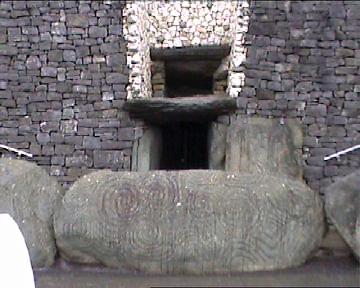
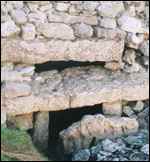
Newgrange (left), and
Carrowkeel (right).
All the mentioned sites have been shown to have been
deliberately constructed so
as to allow the rays of the sun (and/or moon) into the interior of
the passages for very specific time periods only.
One of the stones
from the light-box at Newgrange (below) has a particular design on
it which can be found at two other passage mounds:
Gavr'inis in France, and
Four knocks in Ireland - (which is unusually oriented
to
17�
east of true-north), a feature which is also curiously present at
several Pre-Columbian structures, and suggestive of a preference of
orientation towards a star, or possibly magnetic north, rather than
the more common orientation towards prominent phases of the cycles
of the sun and moon.
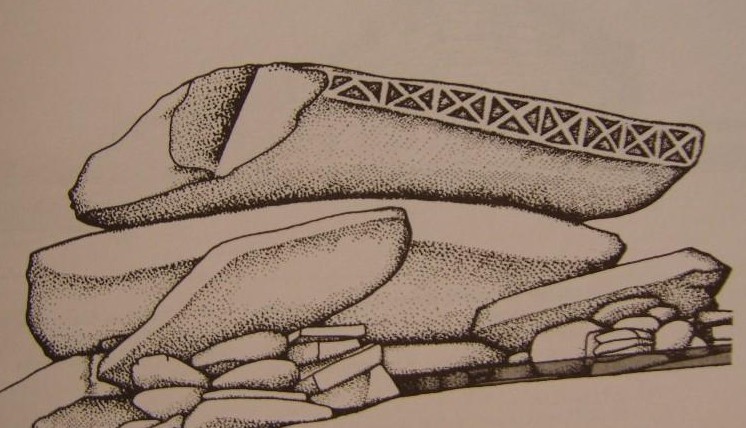
Only 8 crosses are visible today at Newgrange, but it is likely that
there may once have been another, as a section of the front of the
lintel appears to have been lost (a detail not visible following the
reconstruction). If there was another cross, as the picture (right)
suggests, then the total would be the same as the stone at Gavr'inis,
which also has nine crosses on it.
(More
about light-boxes)
|
The Desecration of the Tara Valley Complex: |
The Gabhra (Tara-Skreen) Valley is currently in the
process of being desecrated by the construction of the M3 motorway,
which passes straight through the heart of one of Irelands most sacred
prehistoric landscapes; Destroying over 100 prehistoric sites on the
process.
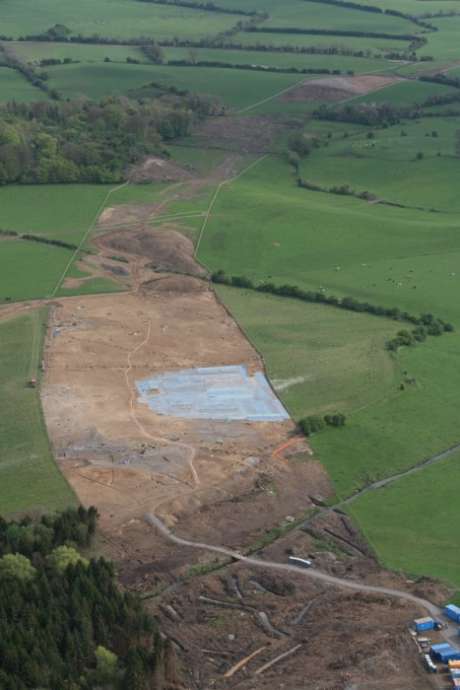
It is only recently that archaeologists are beginning
to view individual sites in terms of their place in the overall
prehistoric landscape.
�The monuments around Tara cannot be viewed
in isolation, or as individual sites, but must be seen in the context of
an intact archaeological landscape, which should not under any
circumstances be disturbed, in terms of visual or direct impact on the
monuments themselves�
Ref: (N3 Navan to Dunshaughlin Route
Selection, August 2000, paragraph 7.3)
Scheduled to open in 2010, the M3's loudest
critics concede much of the damage is already done � 38
archaeological sites unearthed during construction thus far have
been carved from the landscape. Among the now vanished finds, a
newly discovered national monument at Lismullin that one leading
archaeologist described as "the wooden equivalent of Stonehenge."
"All these sites, including the monument at
Lismullin, were part and parcel of the greater whole that is the
Hill of Tara complex and now they are gone, demolished. The damage
is complete and irreversible," said Vincent Salafia of Tara Watch.
"Some would say, `Give up the fight. The deed is done.' But we're
not giving up because what we are most against is the building of
the motorway through the valley that is at the heart of the Tara
complex. It's a long ways from completion and there is still time to
come to our senses.
Ref (http://www.thestar.com/World/Columnist/article/512894)
Opponents of the M3 have called on the European
Parliament and the European Commission to intervene by asking the
Irish government to review its plans and conduct an independent
investigation into the highway�s impact on the Tara landscape.
Campaigners first approached the commission for help in June 2005. The
commission subsequently determined that the road construction violated
EU law governing environmental impact assessments; however, it has yet
to actually submit a case before the European Court of Justice, and
that delay has allowed the Irish government and the Roads Authority to
continue construction. On April 2, 2008, campaigners came before the
EU Parliament�s petitions committee to resolve the problem. An EU
Commission spokesman said the commission would be submitting an
application to the court in the coming months; however, he said the
commission did not have the authority to halt construction in the
interim, as road opponents had hoped.
Ref: (http://www.sacredland.org/world_sites_pages/Tara.html)
The Lismullen henge.
Those who are expert in this area and in the area of Tara are of no
doubt that this ritual site, really a temple, is part of the extended
Tara complex. It is about 500metres from the area of Rath Lugh also
flagged as being under threat of the motorway. This is the place about
which there was such a furore in January. The NRA is trying to fit the
road between these monuments � this was shown in photographs in the
past.
This point in the Gabhra Valley is the entrance to Tara. It was more or
less expected that a Henge would be found in this location. They are
usually associated with Passage Tombs. Conor Newman and Joe Fenwick
recorded the existence of a straight line of Passage Tombs running from
the river Boyne southwards right through the Gabhra Valley and up to the
top of the hill. The Mound of the Hostages is surrounded by a henge
also, this is 200metres in diameter and is much larger than the
Lismullin Henge that is 80metres, still a very large area. These two
Henges are about the same distance apart as Knowth and Dowth are from
each other. No one would doubt that the latter two are related to each
other.
It is therefore no accident that this
Henge is
exactly where it is.
(Ref:
http://www.indymedia.ie/article/82427)
What You Can Do
Learn more about the issue and keep abreast of
new developments by visiting the websites for the
Save Tara
campaign and TaraWatch. You can sign an
online petition addressed to Irish Prime Minister Bertie Ahern,
and join the network of Tara activists through
MySpace
and Facebook. You can also get involved with the New York-based
World
Monument Fund, which is working to protect Tara and other
endangered sites.
(More about Tara Hill)
(Other
Desecrated Megaliths)
|
List and Description of Featured Irish Sites: |
|
Beltany |
Stone circle - Possibly originally a
kerbed passage-mound. |
|
Boyne Valley. |
The Passage mound complex.
Megalithic capital of Ireland. |
|
Browne's
Hill. |
Dolmen with the largest capstone in
Ireland. |
|
Carrowkeel. |
Passage mound complex. Light box
features. |
|
Castleruddery. |
Henge-circle with huge quartz
portal-stones. |
|
Creevykeel. |
One of over 350 'Court-cairn's'
in Ireland. |
|
Dowth. |
Passage mound. Part of the Boyne valley complex. |
|
Drombeg. |
Recumbent stone circle. Solar
orientation. |
|
Fourknocks. |
Passage mound. Highly engraved interior. |
|
Grange Circle. |
Largest Stone Circle in Ireland. |
|
Knocknarea. |
Sacred Hill with huge passage mound on
top. |
|
Knowth. |
Passage mound. Part of the Boyne valley
complex. |
|
Loughcrew. |
Complex of passage-mounds covering
four adjoining hill tops. |
|
Newgrange |
The classic passage mound - Part of the
Boyne Valley complex. |
|
Tara
Hill. |
The 'Sacred heart' of Ireland. |
|












